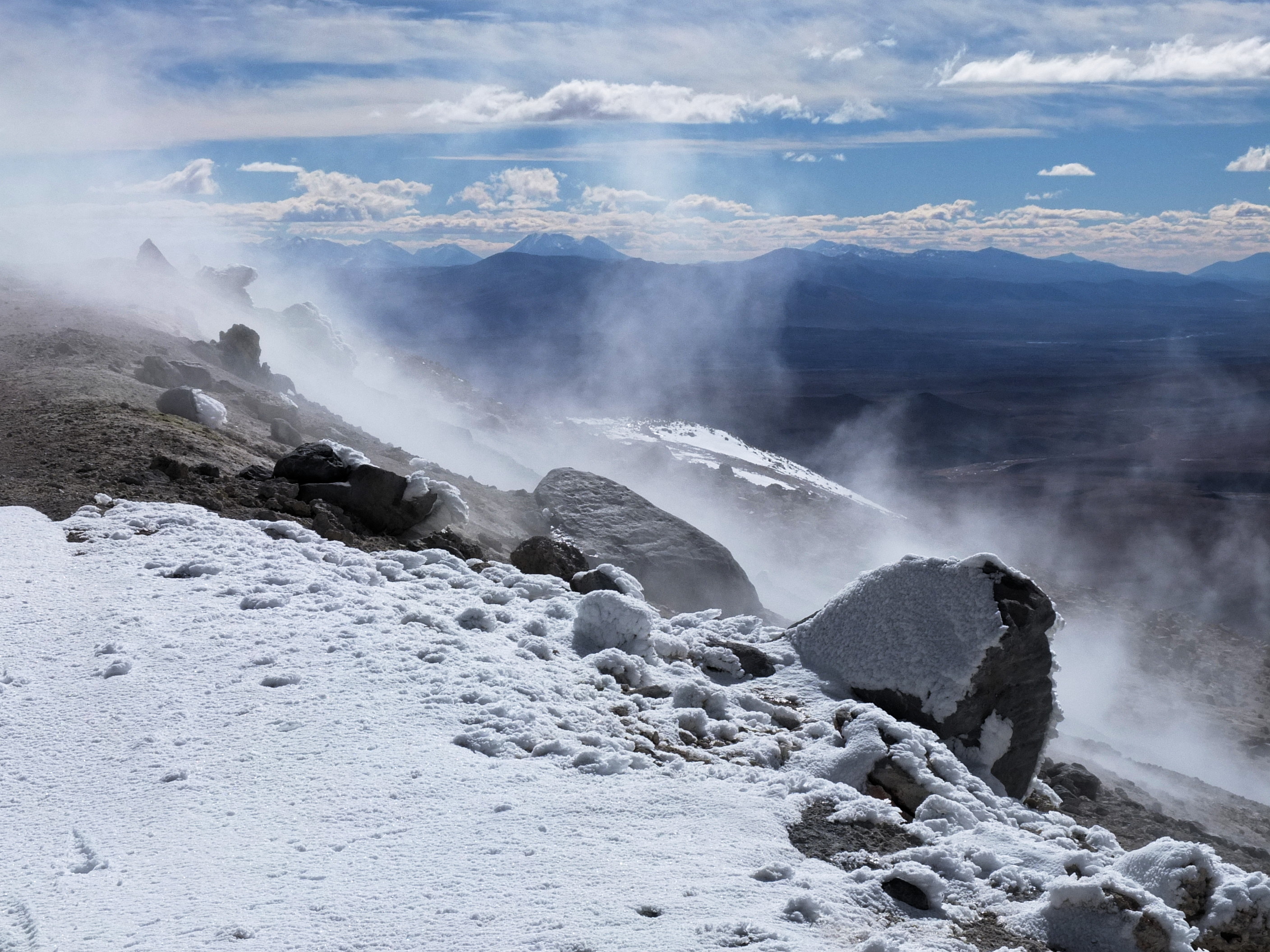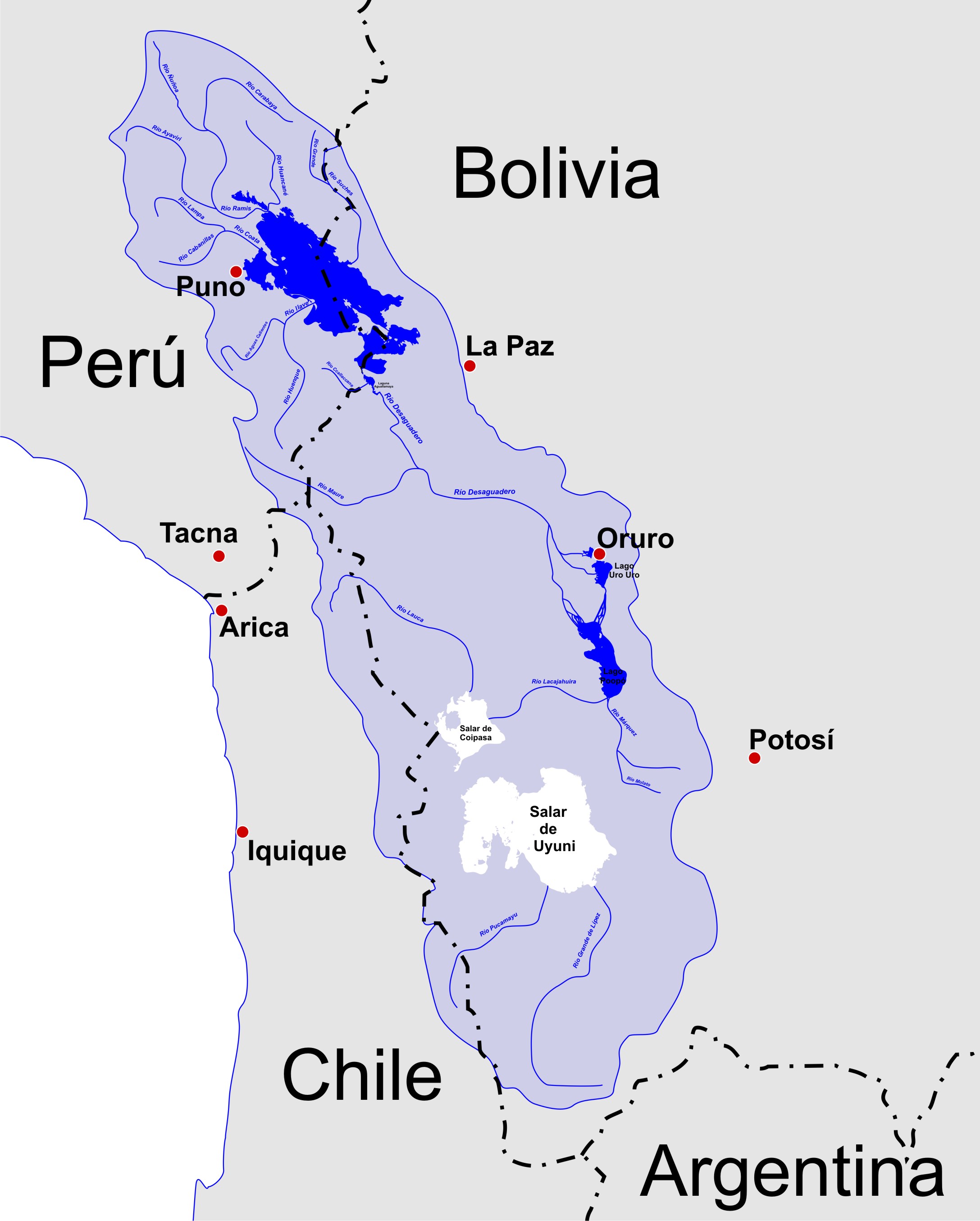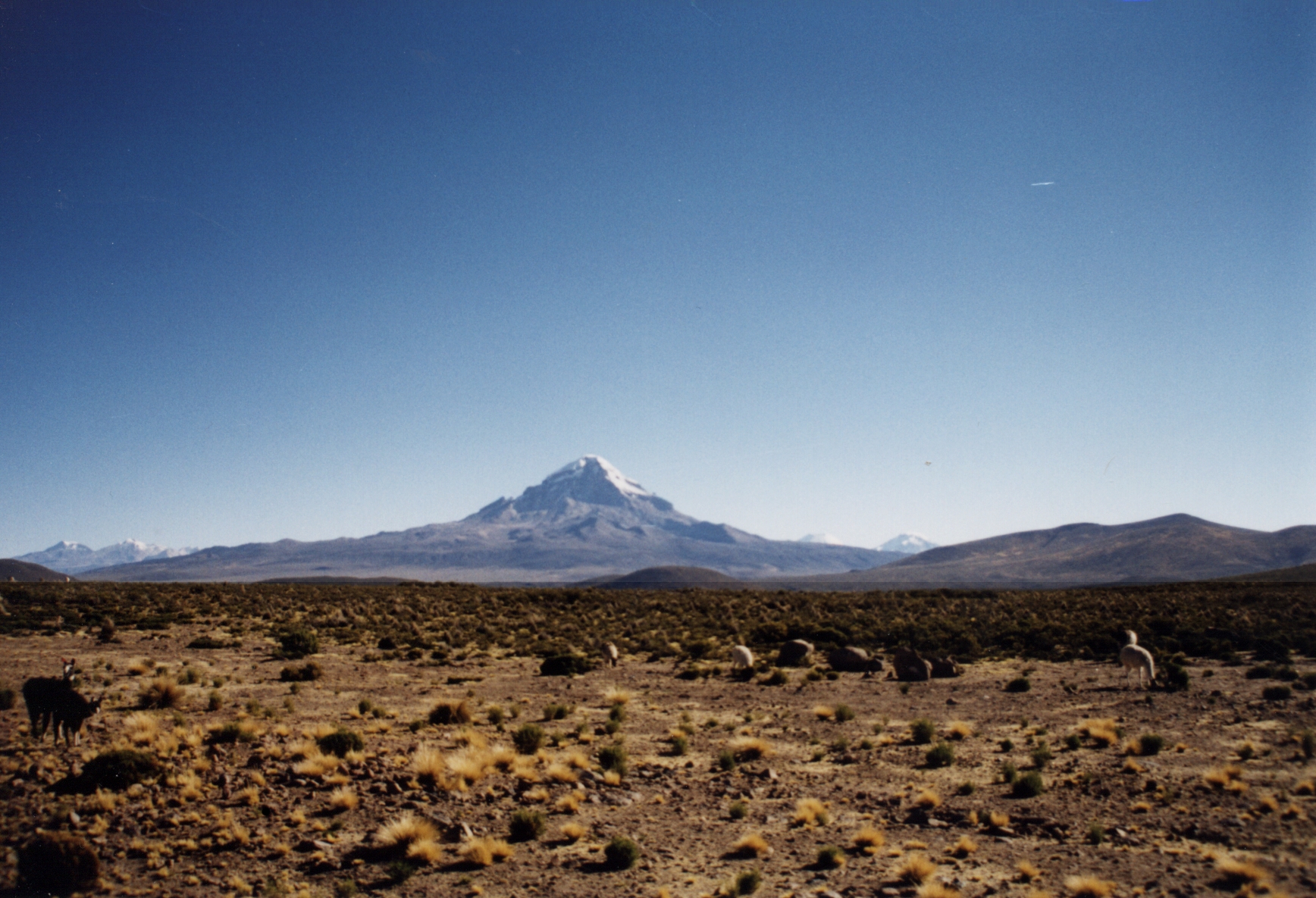|
Cordillera De Lípez
The Cordillera de Lípez is a mountain range in northern Potosí, Bolivia, and northern Argentina, part of the Andes. The range covers an area of 23,404 km2 (9,036 sq mi) and runs in a northeast–southwest direction, between the parallels 22 degrees and 23 degrees, helping to form the boundary between Bolivia and Argentina. Thus the Cordillera de Lípez is a transverse range in the Andes, between the Cordillera Oriental and the Cordillera Occidental, creating the southern boundary of the Bolivian Altiplano. The highest peak is Uturunku at 6,008 m (19,711 ft). Other important peaks are Cerro Lípez (5,929 m) sometimes misidentified as Nuevo Mundo; Soniquera (5,899 m) (sometimes misspelled as Soreguera); and Tinte (5,849 m) which is on the Bolivian-Argentine border. Despite the high elevations, there is no current glacier activity in the Cordillera de Lípez, just some semi-permanent snow fields. Notes #Brain, Y. "Climbs and Expeditions: Bolivia" American Alpine Journ ... [...More Info...] [...Related Items...] OR: [Wikipedia] [Google] [Baidu] |
Cerro Lipez
Cerro is Spanish for "hill" or "mountain". Toponyms ;Bolivia: * Cerro Rico, the "Rich Mountain" containing silver ore near Potosi, Bolivia ;Brazil: *Cerro Branco, a municipality of Rio Grande do Sul *Cerro Grande, Rio Grande do Sul, a municipality of Rio Grande do Sul * Cerro Largo, a municipality of Rio Grande do Sul ;Chile * Cerro de Los Inocentes, in the Juan Fernández Islands ;Cuba: * Cerro, Havana, a district (''municipio'') ;Italy: *Cerro (Bottanuco), a subdivision of Bottanuco in the province of Bergamo *Cerro al Lambro, in the province of Milano *Cerro al Volturno, in the province of Isernia *Cerro Maggiore, in the province of Milano *Cerro Tanaro, in the province of Asti *Cerro Veronese, in the province of Verona ;Mexico: * Cerro Potosí ;United States: * Cerro, New Mexico ;Uruguay: * Cerro Largo Department * Villa del Cerro, in Montevideo * Fortaleza del Cerro, in Montevideo Football clubs * C.A. Cerro, a football club from Montevideo, Uruguay * Club Cerro Cor ... [...More Info...] [...Related Items...] OR: [Wikipedia] [Google] [Baidu] |
Uturunku
Uturuncu is a dormant volcano in the Sur Lípez Province of Bolivia. It is high, has two summit peaks, and consists of a complex of lava domes and lava flows with a total volume estimated to be . It bears traces of a former glaciation, even though it does not currently carry glaciers. Volcanic activity took place during the Pleistocene epoch and the last eruption was 250,000 years ago; since then Uturuncu has not erupted but active fumaroles occur in the summit region, between the two summits. The volcano rises within the Altiplano–Puna volcanic complex, a larger province of large volcanoes and calderas which over the last few million years (mya) have emplaced about of ignimbrites in sometimes very large eruptions. Underneath it lies the so-called Altiplano–Puna magmatic body, a large sill formed by partially molten rocks. Starting in 1992, satellite observations have indicated a large area of regional uplift centered on Uturuncu, which has been interpreted as an indic ... [...More Info...] [...Related Items...] OR: [Wikipedia] [Google] [Baidu] |
Mountain Ranges Of Bolivia
A mountain is an elevated portion of the Earth's crust, generally with steep sides that show significant exposed bedrock. Although definitions vary, a mountain may differ from a plateau in having a limited summit area, and is usually higher than a hill, typically rising at least 300 metres (1,000 feet) above the surrounding land. A few mountains are isolated summits, but most occur in mountain ranges. Mountains are formed through tectonic forces, erosion, or volcanism, which act on time scales of up to tens of millions of years. Once mountain building ceases, mountains are slowly leveled through the action of weathering, through slumping and other forms of mass wasting, as well as through erosion by rivers and glaciers. High elevations on mountains produce colder climates than at sea level at similar latitude. These colder climates strongly affect the ecosystems of mountains: different elevations have different plants and animals. Because of the less hospitable terrain and ... [...More Info...] [...Related Items...] OR: [Wikipedia] [Google] [Baidu] |
David Yetman
David Albert Yetman (born 1941) is an American academic expert on Sonora, Mexico and an Emmy award-winning media presenter on the world's deserts. He is a research social scientist at the University of Arizona. Background Yetman was born in New Jersey, USA. His father was a minister for the Methodist Church. Following the onset of acute asthma, his family moved with him to the dry climate of southern Arizona when he was a teenager. They arrived in Duncan, Arizona in 1954 and then moved to Prescott in 1955 where he went to Prescott High School. Remaining in southern Arizona, in the 1970s he began trading carvings made by the Seri Indians of Sonora, Mexico and began to investigate their livelihoods and culture (Yetman 1988). He also worked in the Chiricahua Mountains. He completed a PhD in philosophy (University of Arizona, 1972). In 1977 he ran for political office and was elected to the Pima County Board of Supervisors as a Democrat, serving until 1988. He used this role to pres ... [...More Info...] [...Related Items...] OR: [Wikipedia] [Google] [Baidu] |
American Alpine Journal
The ''American Alpine Journal'' is an annual magazine published by the American Alpine Club. Its mission is "to document and communicate mountain exploration." The headquarters is in Golden, Colorado. Subtitled as a compilation of "The World's Most Significant Climbs," the magazine contains feature stories about notable new routes and ascents, written by the climbers, as well as a large "Climbs and Expeditions" section containing short notes by climbers about new and noteworthy achievements. Some general articles about mountaineering, mountain medicine, the mountain environment, or other topics are also sometimes included. Each issue includes book reviews, memorials of deceased members, and club activities. History The journal was established in 1929. In 1957 and 1958, the editor was Francis P. Farquhar. From 1960 to 1995, the editor was H. Adams Carter, who brought the journal to international pre-eminence. From 1996 to 2001, the editor was Christian Beckwith. Since 2002, ... [...More Info...] [...Related Items...] OR: [Wikipedia] [Google] [Baidu] |
Soniquera
Suni K'ira ( Quechua ''suni'' 'long', ''k'ira'' 'prop, support'; hispanicized spellings ''Sonequera, Soniquera, Suniquera, Suniquira'') is a shield volcano in Bolivia. It is located in the Potosí Department, Nor Lípez Province, Colcha "K" Municipality, and in the Sud Lípez Province, San Pablo de Lípez Municipality. It lies north of the Uturunku volcano. The volcano rises above the surrounding terrain. Suni K'ira is the source of an ignimbrite, and it features a caldera at the intersection of several faults. The volcano features cirques which were formerly considered to be craters, leading to the belief that eruptions occurred during the Holocene. Rock samples taken from Suni K'ira consist of andesite and dacite. The former contains latite and quartz and the latter biotite and hornblende. ''Polylepis tarapacana ''Polylepis tomentella'', known in its native habitat by the Spanish common name ''queñoa de altura'' (polylepis or quenoa of ighaltitude), is a sh ... [...More Info...] [...Related Items...] OR: [Wikipedia] [Google] [Baidu] |
Nuevo Mundo Volcano
Nuevo Mundo also known as Jatun Mundo Quri Warani (Hispanicized spellings ''Jatun Mundo Khori Huarani, Jatun Mundo Khorihuarani''), is a stratovolcano, lava dome and a lava flow complex between Potosí and Uyuni, Bolivia, in the Andes rising to a peak at . It is located in the Potosí Department, Antonio Quijarro Province, Tomave Municipality. It lies northeast of the peaks of Uyuni, Kuntur Chukuña and Chuqi Warani and south of Sirk'i. Name The term "Jatun Mundo Quri Warani" contains Quechua and/or Aymara words (''jatun'' "big", ''quri'' "gold", ''warani'' "the one with a scepter" or " constellation"). ''Mundo'' (Spanish for "world") is possibly a Hispanicized or a broken word of native origin. As it is an unusually long name it may erroneously be composed of two alternate names, either Jatun Mundo or Quri Warani, as occurred with Pacha Qullu (or Kimsa Misa) which is also sometimes regarded as ''Pacha Kkollu Quimsa Misa''. In 1995 the Bolivian government used the term "Jatun ... [...More Info...] [...Related Items...] OR: [Wikipedia] [Google] [Baidu] |
Cerro Lípez
Cerro Lípez (also Cerro Lipez) is a stratovolcano in the Cordillera de Lípez in the Sud Lípez Province of the Potosí Department in southwestern Bolivia. It has twin peaks and rises to 5,933 m. On some maps it is incorrectly labeled as Nuevo Mundo. Nuevo Mundo Nuevo is the Spanish word for "new". It may refer to: * Nuevo, California, a town in the state of California * Nuevo (band), featuring singer and musician Peter Godwin * Nuevo (Bayamón), a settlement in Puerto Rico * "Nuevo", Spanish-language vers ... is in fact hundreds of kilometres to the northeast and five hundred metres shorter. The confusion came in part from a misidentification of the height of Nuevo Mundo. See also * List of volcanoes in Bolivia Notes Stratovolcanoes of Bolivia Volcanoes of Potosí Department Five-thousanders of the Andes {{Potosí-geo-stub ... [...More Info...] [...Related Items...] OR: [Wikipedia] [Google] [Baidu] |
Altiplano
The Altiplano (Spanish for "high plain"), Collao ( Quechua and Aymara: Qullaw, meaning "place of the Qulla") or Andean Plateau, in west-central South America, is the most extensive high plateau on Earth outside Tibet. The plateau is located at the latitude of the widest part of the north-south-trending Andes. The bulk of the Altiplano lies in Bolivia, but its northern parts lie in Peru, and its southwestern fringes lie in Chile. There are on the plateau several cities in each of these three nations, including El Alto, La Paz, Oruro, and Puno. The northeastern part of the Altiplano is more humid than the southwestern part, which has several salares (salt flats), due to its aridity. At the Bolivia–Peru border lies Lake Titicaca, the largest lake in South America. Farther south, in Bolivia, there was until recently a lake, Lake Poopó, but by December 2015 it had completely dried up, and was declared defunct. It is unclear whether that lake, which had been the second-large ... [...More Info...] [...Related Items...] OR: [Wikipedia] [Google] [Baidu] |
Cordillera Occidental, Bolivia
Topographic map of Bolivia showing (east to west) plains of Cordill.html" ;"title="Geology of Bolivia#Lowlands and Sub-Andean zone">Sub-Andean Zone in red, Cordillera Oriental (Bolivia)">Eastern Cordillera in white, Altiplano in gray, and Western Cordillera in white The Cordillera Occidental or Western Cordillera of Bolivia is part of the Andes (that is also part of the American Cordillera), a mountain range characterized by volcanic activity, making up the natural border with Chile and starting in the north with Juqhuri and ending in the south at the Licancabur volcano, which is on the southern limit of Bolivia with Chile. The border goes through the innominated point located at two-thirds of elevation of Licancabur's northeastern slope at the southwestermost point of Bolivia at 22° 49' 41" south and 67° 52' 35" west. The climate of the region is cold and inadequate for animal and plant life. Its main feature is its ground, in which are large quantities of metallic minerals i ... [...More Info...] [...Related Items...] OR: [Wikipedia] [Google] [Baidu] |
Cordillera Oriental, Bolivia
The Cordillera Oriental or Eastern Cordillera is a set of parallel mountain ranges of the Bolivian Andes, emplaced on the eastern and north eastern margin of the Andes. Large parts of Cordillera Oriental are forested and humid areas rich in agricultural and livestock products. Geologically, the Cordillera Oriental is formed by the Central Andean fold and thrust belt. The Bolivian tin belt lies in the cordillera. Division Topographic map of Bolivia showing (east to west) plains of Sub-Andean Zone in red, Eastern Cordillera in white, Western Cordillera in white">Altiplano in gray, and Cordillera Occidental (Central Andes)">Western Cordillera in white The cordillera can be divided into three sections in Bolivia and one in northwestern Argentina: * The northern section is a continuous mountain range like Eslabón, San Buenaventura, Muchane, Pilón, etc. and between its important summits you can find Astalaya and Cerro Colorado. * The central section was formed entirely by the ... [...More Info...] [...Related Items...] OR: [Wikipedia] [Google] [Baidu] |






